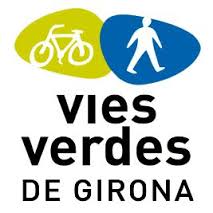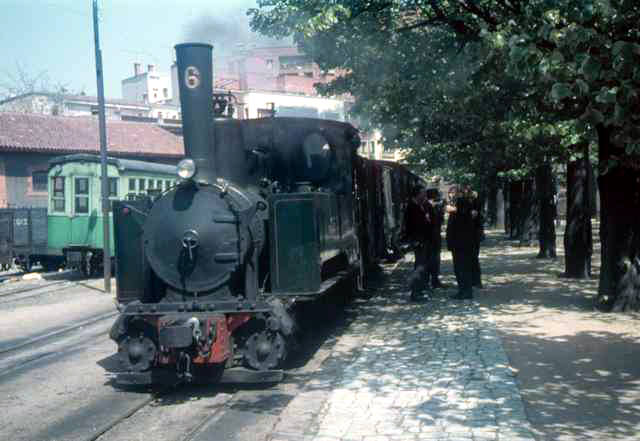 |
Gerona station:
Here we can see the station lanes on a sunny day. One may think that the train was right in the middle of the street since the lanes look so much like your everyday street.
A la izquierda se puede ver el depósito de locomotoras, orientado de extraña forma cerrando el patio que quedaba enre los muelles de carga y la estación del carrilet.
Picture taken by Charles F. Firminger (20 april, 1968)
|
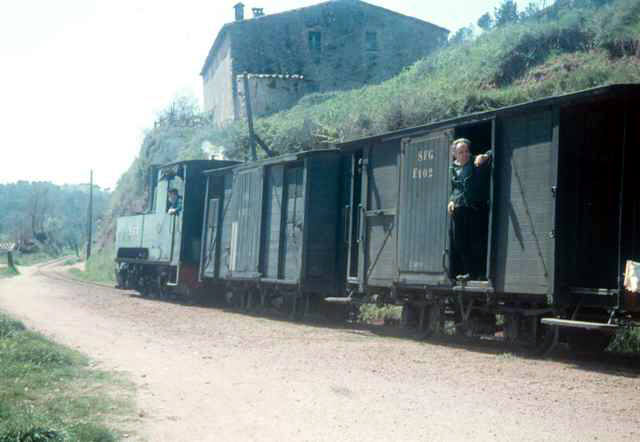 |
The Creueta halt:
A view of the train in which one can view the comercial cars closed. The very first one is a M model car and the second one is a F model. Due to being so close to Gerona (3km), the creueta zone only had a little space for an additional few buildings, including a typical Catalan farmhouse that you can see on the top right of the picture. It is actually called "Can Maige"
Picture taken by Charles F. Firminger (20 april, 1968)
|
|
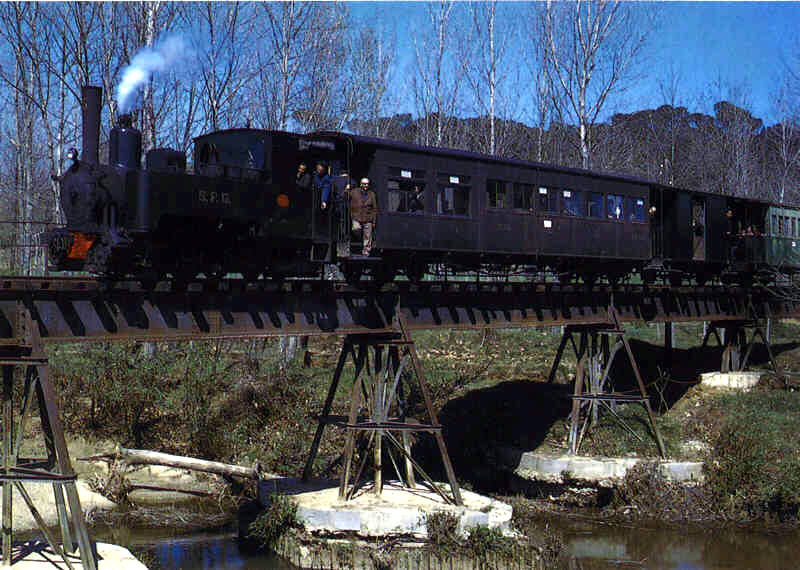
|
Onyar river bridge:
The nº5 locomotive carries a train over the Onyar river.
The metallic bridge can be seen along with its metallic pilars, strongly attached to their corresponding concrete blocks.
In fact, most of the bridges had the same structure, with a single slightly protected lane for the pedestrians to pass by.
Picture taken by Jaume Morell
|
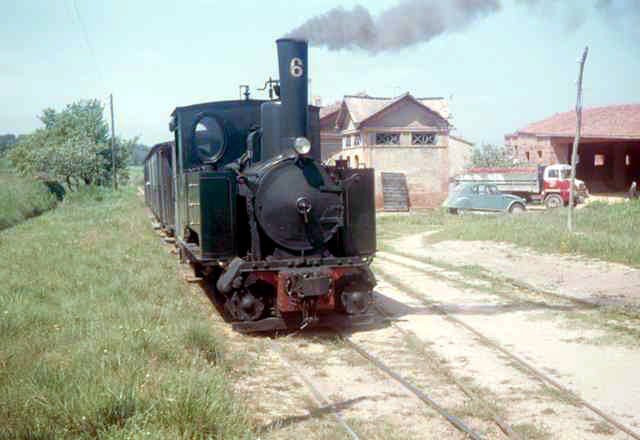 |
Quart station:
6 km away from Gerona lies the Quart station. There in Quart d'Onyar, the town is recognised by its close cities due to Quart's hand made clay utils.
But as time went on, Quarts diversified its economy with the installment of a few totally new industries that would pretty much need the train station to operate.
Picture taken by Charles F. Firminger, on April the 20th, 1968
|
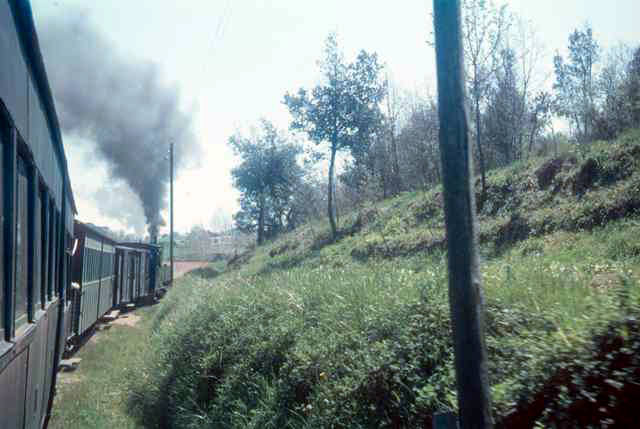 |
Between Quart and Llambilles:
There's one single train from Gerona that makes its way through the flat zone "Riberas de l'Onyar", that leads to Lambillas. One may appreciate the amount of smoke coming out of the locomotive, which indicates how much effort the machine is actually putting on getting up that 0,0018m ramp.
Picture taken by Charles F. Firminger, on April the 20th, 1968
|
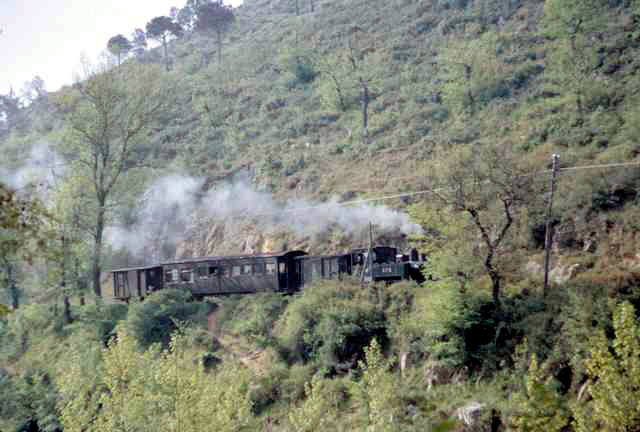 |
On the way to Llambilles:
Right inbetween of Quart and Lambillas the locomotive encounters a 0,0019m ramp.
It is the strongest bit of the "Erols" route, and it leads to the Bugantó river valley.
Picture taken by James J. Jarvis, on April the 29th, 1967
|
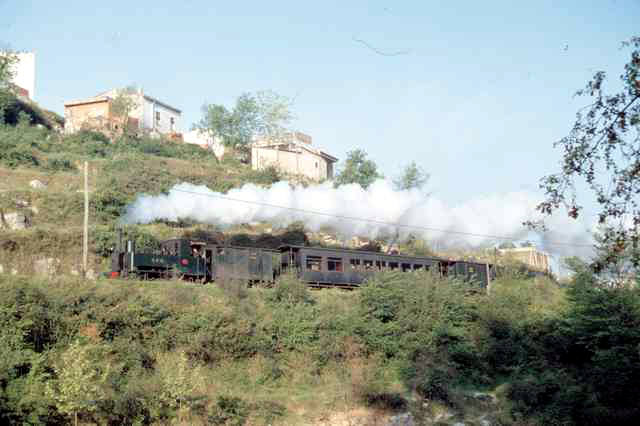 |
The Quart ramp:
J. Jarvis took this picture from the Carmen street on Gerona, near the Montilivi neighborhood, that can be seen on the top of the picture.
There was a slight curve where the people would get prepared before catching the train while on movement!
Picture taken by James J. Jarvis, on April the 29th, 1967
|
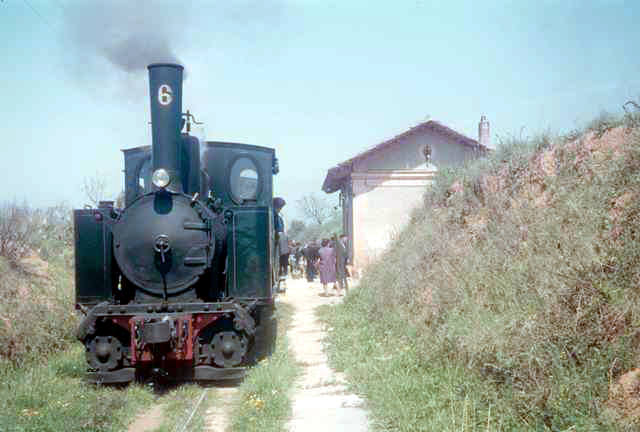 |
Llambilles halt:
A 8,5 kilómetros de Gerona se encontraba el apeadero de Llambilles. Algo alejado del pueblo congregado alrededor de la iglesia dedicada a San Cristóbal.
El pueblo, dedicado a labores del campo fue perdiendo población a lo largo de los años, haciendo que el apeadero se utilizara escasamente para el tránsito de mercancías.
Picture taken by Charles F. Firminger, on April 20th, 1968
|
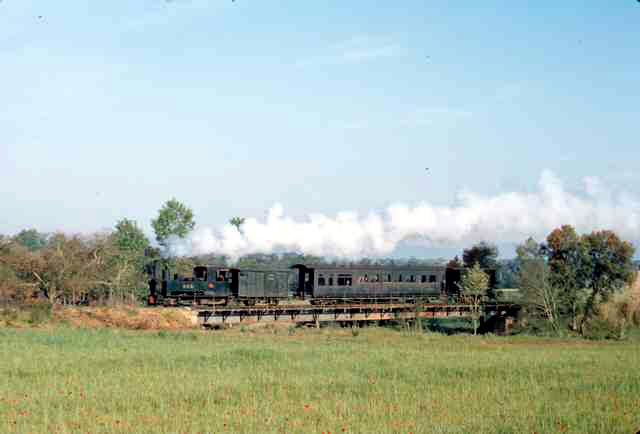 |
Puente sobre el Río Bugantó:
A 9,9 kilómetros de Gerona se encuentra el puente sobre el rio Bugantó.
Los puentes de la línea fueron hechos con piezas de 10 metros, así en este caso este puente de 30 m. sobre el río Bugantó tiene tres piezas metálicas apoyadas sobre dos pilares.
En este caso es la locomotora número 5 la que lo atraviesa con destino a Gerona.
Foto tomada por James J. Jarvis el 29 de abril de 1967
|
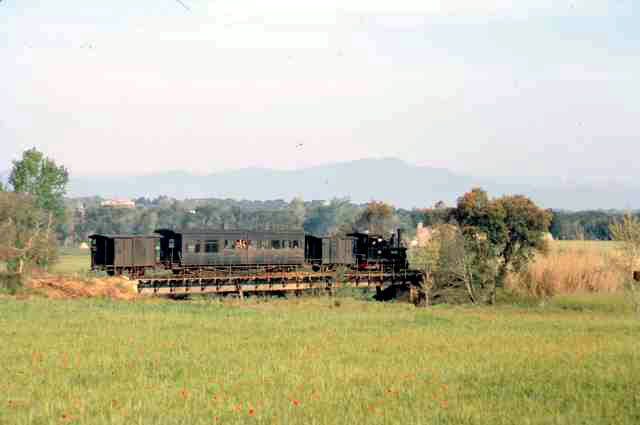 |
Puente sobre el Río Bugantó:
El fotógrafo se esperó a que pasara el tren en sentido contrario por el mismo puente, así ha podido comprobar que la locomotora nº 6 arrastraba el mismo tren con destino a Sant Feliu.
A partir de aquí se produce el tren entra en una trinchera, al final de la cual se encontraba el apeadero de Llebrers.
Foto tomada por James J. Jarvis el 29 de abril de 1967
|
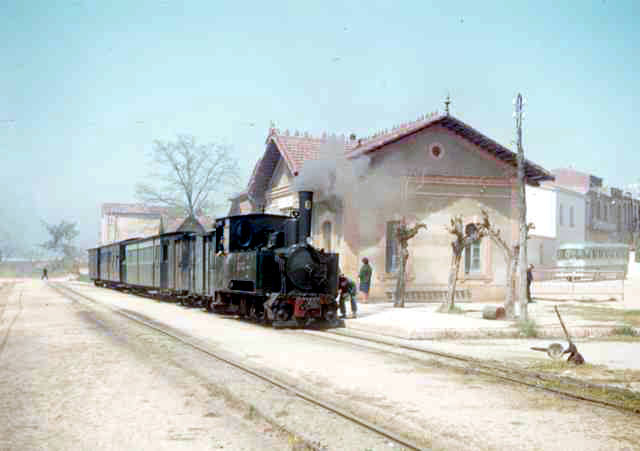 |
Estación de Cassà de la Selva:
A 13,5 kilómetros de Gerona se encontraba la estación de Cassà de la Selva. Desde 1650, año en que la peste negra asoló Cataluña, se comenzó a forjar un nuevo oficio en Cassà, el de taponero. .
En este pueblo se manufactuban toda serie de elaborados del corcho, sobre todo los tapones eran muy apreciados por los vinateros franceses.
Foto tomada por Charles F. Firminger el 20 de abril de 1968
|
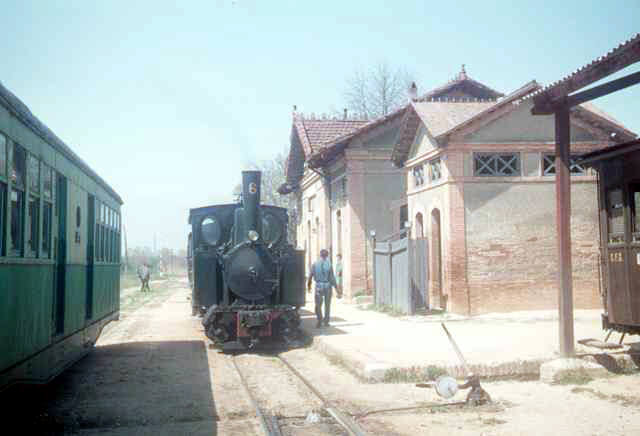 |
Estación de Llagostera:
A 21 kilómetros de Gerona se encontraba la estación de Llagostera. Llagostera, antaño protegida por su castillo, era un cruce de caminos importante entre las comarcas interiores y la costa.
A partir de aquí comienza el macizo de Les Gavarres, lugar poblado de encinas y alcornoques, que dieron abundante vida al pequeño tren de Sant Feliu para el acarreo de planchas, tapones y elaborados del corcho.
Foto tomada por Charles F. Firminger el 20 de abril de 1968
|
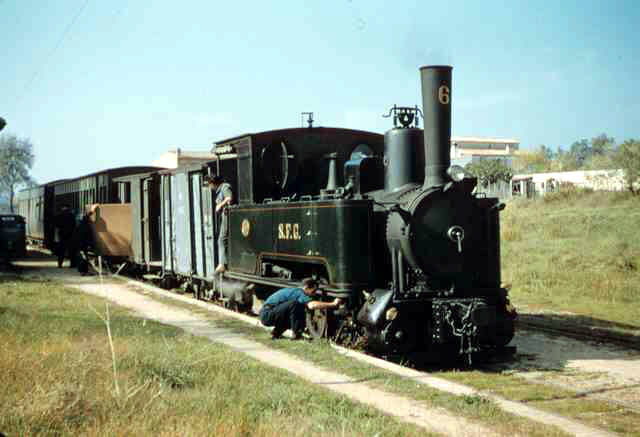 |
Estación de Santa Cristina:
A 32 kilómetros de Gerona se encontraba la estación de Santa Cristina d'Aro. Desde que el tren entra en la Vall d'Aro (nombre con el que se conoce al valle del río Ridaura), pasa por el apeadero de Font Picant (famoso por ser lugar de excursión y por tener una conocida fuente de agua termal) y baja lentamente hasta Santa Cristina d'Aro.
En la entrada de la estación había un paso a nivel con la carretera de Palamós, bastante transitada en los últimos tiempos debido al turismo.
Foto tomada por James J. Jarvis el 29 de abril de 1967
|
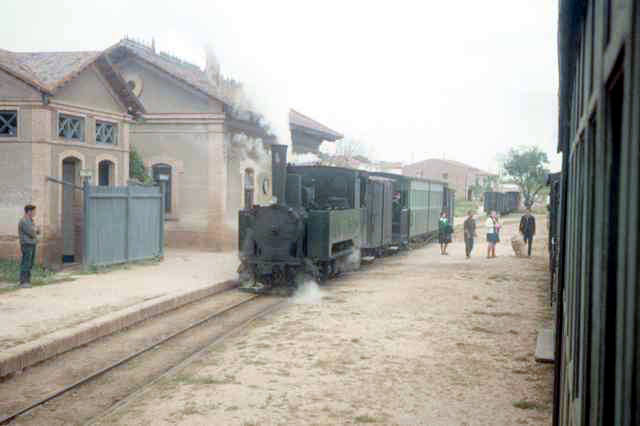 |
Estación de Castell d'Aro:
A 34 kilómetros de Gerona se encontraba la estación de Castell d'Aro. El castillo de los Benedorminos fue el comienzo de este pueblo en la edad media, que fue creciendo alrededor del mismo..
Castell d'Aro fue siempre un pueblo de tradiciones, por lo que se enorgullece de haber preservado el pesebre viviente más antiguo de Cataluña y un mercado medieval.
Foto tomada por Charles F. Firminger el 20 de abril de 1968
|
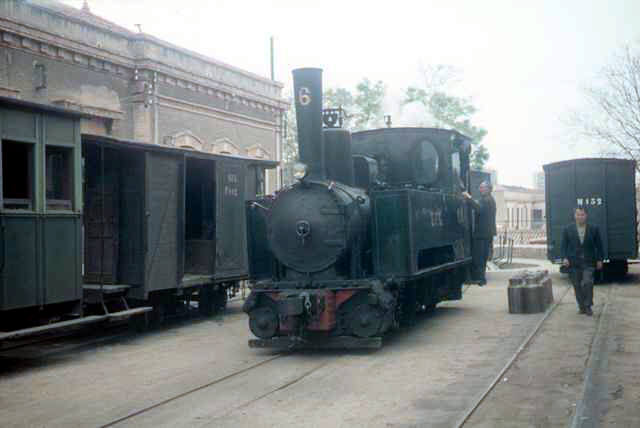 |
Estación de San Feliu de Guixols:
A 39 kilómetros de Gerona se encontraba la estación de Sant Feliu de Guixols. En tren entraba por levante procedente de S'Agaró paralelo a la línea de mar. A unos 400 metros antes de llegar a la estación se separaba el ramal al puerto de Sant Feliu de Guixols, la línea giraba hacia el norte por el margen de la riera y sube un corto trecho, mediante una curva a izquierdas atraviesa la riera y se adentra por el norte en el centro de Sant Feliu.
En una amplia explanada se levantan los talleres, muelles de carga y la estación, lo más próxima posible al centro histórico de Sant Feliu.
Foto tomada por Charles F. Firminger el 20 de abril de 1968
|
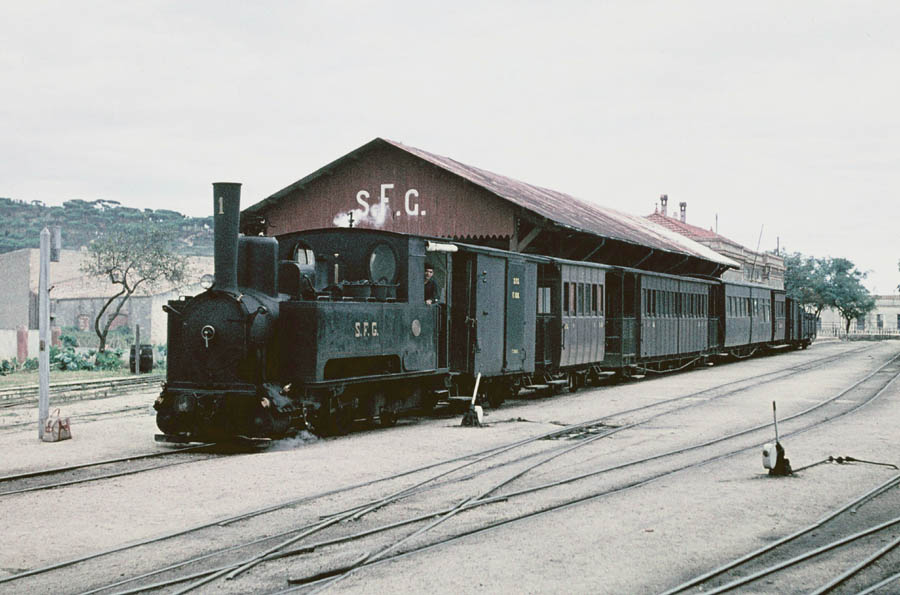 |
Estación de San Feliu de Guíxols:
Tren circulando de nuevo hacia Gerona con la locomotora número 1 al frente. Se puede comprobar que aún se utilizaban vagones de dos ejes en las composiciones a principios de los años 60.
Fruto de un pequeño contratiempo que tuvo el autor de la foto, al cual se le estropeó el coche, tuvieron que ir en tren hasta Gerona.
Foto tomada por John Carter en 1960
|



















